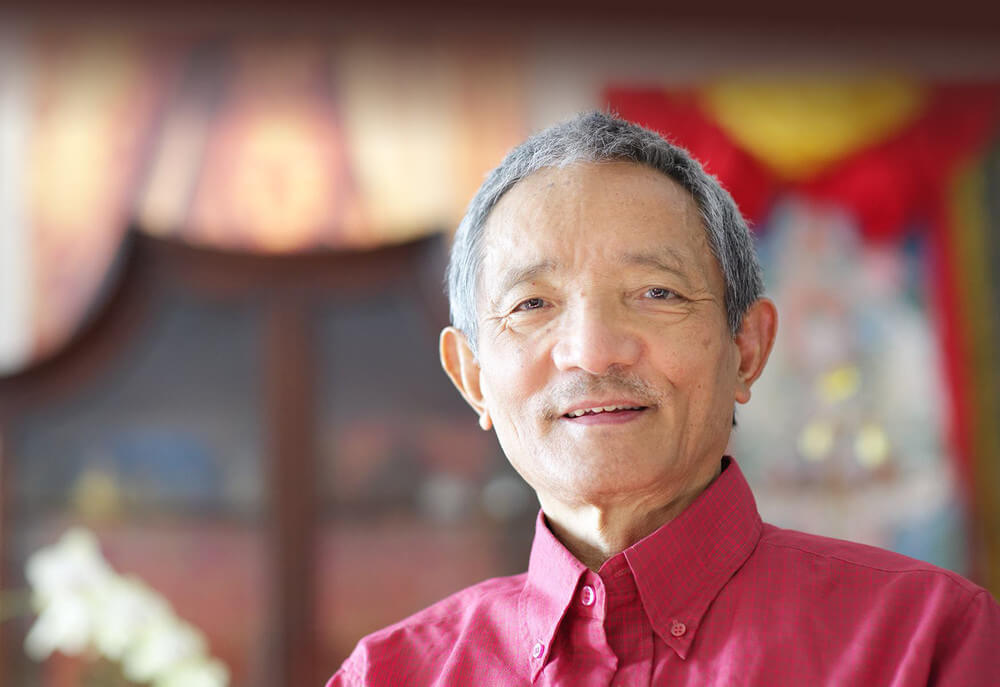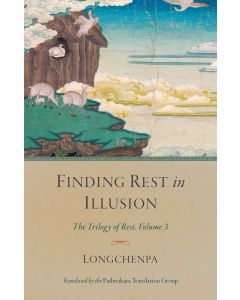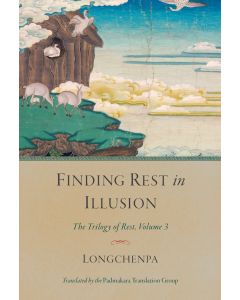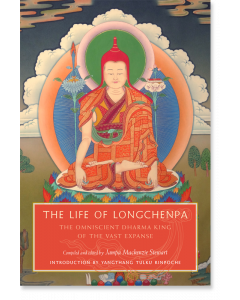See Also: Dudjom Tersar | Longchen Nyingtig | Namcho & Palyul
___________________
Guru Rinpoche | Mandarava | Rongzompa | Longchenpa | Jigme Lingpa | Patrul Rinpoche |
Sera Khandro | Mipham Rinpoche | Dilgo Khyentse | Dudjom Rinpoche
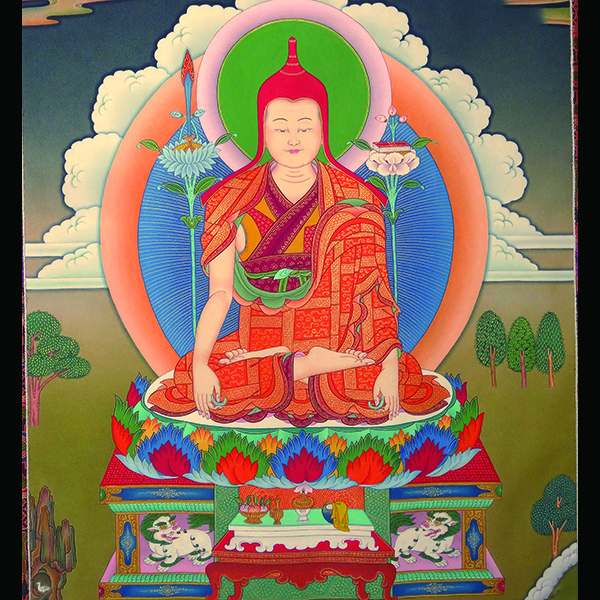

Longchen Rabjam (1308–1363), also known as Longchenpa, is a great luminary of Tibetan Buddhism. He was highly skilled in all aspects of scholarship from an early age and excelled throughout his life in the practice and accomplishment of the Dharma. Regarded as a great Dzogchen master, Longchenpa had many pure visions where he was given direct instructions from Guru Padmasambhava and is recognized as an emanation of Vimalamitra. Longchenpa’s prolific writings have made him one of Tibet’s most renowned and precious teachers.
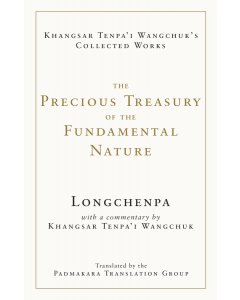
By Longchenpa
By Khangsar Tenpa'i Wangchuk
Translated by Padmakara Translation Group
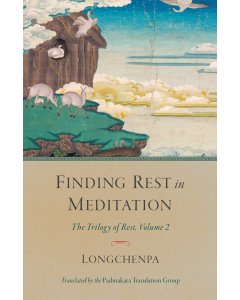
By Longchenpa
Translated by Padmakara Translation Group
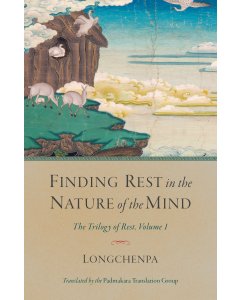
By Longchenpa
Translated by Padmakara Translation Group
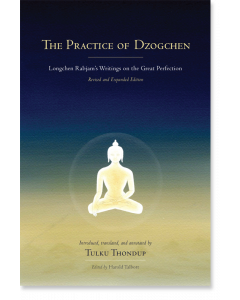
By Longchenpa
Translated by Tulku Thondup
Edited by Harold Talbott
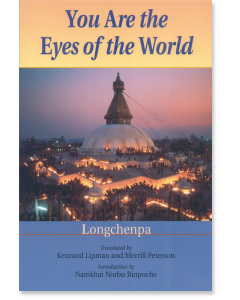
By Longchenpa
Translated by Kennard Lipman
Translated by Merrill Peterson
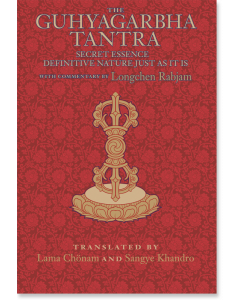
By Longchenpa
Translated by Lama Chonam
Translated by Sangye Khandro
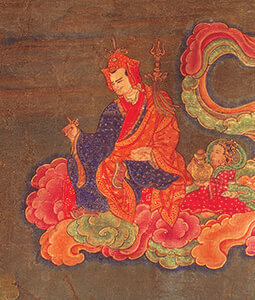
The Guhyagarbha Tantra: A Reader's Guide to the Glorious Secret Essence

See Also: Dudjom Tersar | Longchen Nyingtig | Namcho & Palyul
___________________
Guru Rinpoche | Mandarava | Rongzompa | Longchenpa | Jigme Lingpa | Patrul Rinpoche |
Sera Khandro | Mipham Rinpoche | Dilgo Khyentse | Dudjom Rinpoche
As Kyabje Dungse Thinley Norbu Rinpoche has said, "The ultimate source for the entirety of Sutra and Tantra is the King of Tantras, The Guhyagarbha, Glorious Secret Essence." The Guhyagarbha Tantra summarizes the heart of all eighteen great Mahayoga tantras and is the general tantra of the category of enlightened mind. This Secret Essence Tantra is the most advanced and extensively studied tantra within the Nyingma lineage; and its twenty-two chapters elucidate how to correctly view the ground, traverse the path, and ultimately reach the result-fully enlightened buddhahood.
The tantra of the Glorious Secret Essence (the Guhyagarbha Tantra) extracts the essence of the eighteen Mahayoga tantras and is also the general tantra of enlightened mind. The twenty-two chapters of this tantra describe the three tantras of the ground path and result and explain the topics of tantra needed to perfect the practice.
Studying the Secret Essence is crucial for all who seriously wish to learn any of the three inner tantras, as Mahāyoga is the foundation of all the inner tantras and the Secret Essence is the root tantra of Mahāyoga. The great Mipham writes, “One must learn the tantric trainings by relying on Mahāyoga, as it teaches the ground, path, and result of all tantric cycles.” He also says, “Correct understanding of the visions of all three inner tantras depends on understanding the Secret Essence.” The Secret Essence is also the source of numerous teachings on the one hundred peaceful and wrathful deities, one volume of which—the Tibetan Book of the Dead—is quite popular in the West.
Please note that many of the books listed here require that you have received certain teachings and/or empowerments. Please see the respective book pages for details. Until you receive them, the books are best used as something for your shrine.
$150.00 - Hardcover
By Longchenpa
Translated by Lama Chonam and Sangye Khandro
The twenty-two chapters of this tantra elucidate how to correctly view the ground, traverse the path, and ultimately reach the result—fully enlightened buddhahood.
The first part of this book includes the Tibetan and English translation for the root tantra itself.
The second part of this volume is a translation of the extensive com1nentary on The Guhyagarbha Tantra called Thorough Dispelling of Darkness throughout the Ten Directions written by the omniscient Longchenpa, who was an actual emanation of Samantabhadra. His word-for-word commentary gives uncommon explanations regarding all stages of Vajrayana practice, including comprehensive teachings from the Dzogchen point of view on how to practice and accomplish the path to enlightenment. The author includes complete explanations of the peaceful and wrathful mal).cJalas, as well as practical instructions needed to attain the four states of vidyadharahood.
By Jamgon Mipham Rinpoche
Translated by Lama Chonam and Sangye Khandro
This commentary on the Secret Essence by Mipham Rinpoche illuminates all the crucial points of the entire path of Secret Mantra Vajrayana. The teachings contained in Essence of Clear Light are not only useful for dharma practice in general but are especially applicable for the practice of the three innermost yogas of Secret Mantra. For that application there are the eleven topics well known throughout the teaching of tantra that are clearly elucidated in this text. The topics are: the nature as it is, the view immovable, samadhi forsaking the pass, conduct the array, mandala traversing the stages, empowerment not transgressing, samaya pursuing the goal, accomplishment presentation to the places, offerings the manifestation, enlightened activity binding, mudra and recitation, and mantra. These topics are the crucial points of the path through which the common and supreme siddhis are brought to fruition.
As Mipham Rinpoche points out in this commentary, if these topics are not understood, then there is no other method through which the final result on the path can be achieved. In brief, this excellent text brings an undeniable understanding that all dualistic phenomena arising from the ignorance of grasping and fixating are primordially pure as the truth of inseparable purity and evenness, or the great dharmakaya. Aside from realizing this view, there is no other method through which to receive the genuine wisdom transmission of the lineage of the vidyadhara masters. This doctrine of the great secret, the Guhyagarbha Tantra is the heart essence of a million wisdom dakinis and the path that was traversed by the accomplished vidyadharas of India and Tibet.
$95.00 - Hardcover
$34.95 - Hardcover
By Mipham Rinpoche
Translated by the Dharmachakra Translation Committee
Mipham's explanation of this text, here translated for the first time, is one of the most celebrated commentaries on the Tantra of the Secret Essence, which today occupies an important place in the tantric curriculum of Tibetan monastic colleges. Luminous Essence is a specialized guide meant for initiated tantric practitioners. To fully appreciate and assimilate its message, it should be studied under the guidance of a qualified teacher by those who have received the appropriate empowerments, reading transmissions, and oral instructions.
By Dodrupchen Jigme Tenpa'i Nyima
Translated by Lama Chonam and Sangye Khandro
As the author Dodrupchen Tenpa'i Nyima himself has said, this glorious Secret Essence Tantra possesses eight great features. It is the king of all tantras, pinnacle of all vehicles, origin of all doctrines, general commentary for all scriptural transmissions, core wisdom, intent of all the victorious ones, ultimate state of all results, path that all tathagatas have embarked upon, and great path of all true practitioners. Commentary to the Guhyagarbha Tantra, the Key to the Precious Treasury, synthesizes the meaning of all eighteen Mahayoga tantras from the perspective of the author's personal realization and authoritative scholarship. As the means through which serious practitioners can realize the truth of inseparable purity and evenness, this teaching is the guide for knowing how to internalize the Secret Mantra path of the generation and completion stages.
Th ere are a number of major commentaries3 on the Secret Essence; however, Ihas become one of the four most popular commentaries. It was written by the Third Dodrupchen, a highly
respected scholar and adept. Referring to the Third Dodrupchen’s famous treatise about memory, the Th irteenth Dalai Lama noted, “Today, a writer of this quality is very rare in this land.” The present Dalai Lama has frequently praised the Third Dodrupchen’s writings, too. He says, “Reading Dodrupchen was as if he were stroking my head in confirmation, giving
me confidence that my insight was not unfounded.”
$95.00 - Hardcover
$59.00 - Hardcover
**Note: Books 15-17 is purchased as a single item but is in fact two separate books that ship wrapped together.
By Choying Tobden Dorje
Translated by Gyurme Dorje
Contributions by Lama Tharchin
Two of the books of the Complete Nyingma Tradition, the masterpiece and most extensive presentation of the Nyingma thought and practice available in English, are focused on the Guhyagarbha Tantra. The two books present the entire text of the Guhyagarbha Tantra, in Tibetan and English, together with the interlinear sections of one of its most important commentaries, Dispelling the Darkness of the Ten Directions, by the outstanding fourteenth-century master Longchen Rabjam. Also included is Choying Tobden Dorje’s rewriting of Candragomin’s inspirational Extensive Commentary on the Sublime Litany of the Names of Manjushri.
$24.95 - Paperback
By Ringu Tulku
Ringu Tulku provides several pages on the Guhyagarbha Tantra in his elucidation of the Ri-Me (Rimé) tradition, including its transmission from King Ja to his son Kukuraja to Lialitavajra and Buddhaguhya, who wrote the famous commentary, The Commentary on the Distinctions. Other Indian commentaries include those by Chandragomin and Guru Rinpoche (The Great Explanation by Padma).
The next section describes the Guhyagarbha teaching lineages in Tibet, highlighting masters like Vimalamitra, Ma Rinchen Chok, Nyak Jnanakumara, Nupchen Sangye Yeshe, Katog Dampa Desheg, Rongzompa, Longchenpa, the Zur lineages, and many more.
The following section delves into the three styles of teaching on the tantra:
$22.95 - Hardcover
By Padmasambhava and Mipham Rinpoche
A Garland of Views presents both a concise commentary by the eighth-century Indian Buddhist master Padmasambhava on a chapter from the Guhyagarbha Tantra on the different Buddhist and non-Buddhist philosophical views, including the Great Perfection (Dzogchen), and an explicative commentary on Padmasambhava’s text by the nineteenth-century scholar Jamgön Mipham (1846–1912).
Padmasambhava’s text is a core text of the Nyingma tradition because it provides the basis for the system of nine vehicles (three sutra vehicles and six tantra vehicles) that subsequently became the accepted way of classifying the different Buddhist paths in the Nyingma tradition.
Mipham’s commentary is the one most commonly used to explain Padmasambhava’s teaching. Mipham is well known for his prolific, lucid, and original writings on many subjects, including science, medicine, and philosophy, in addition to Tibetan Buddhist practice and theory.
$29.95 - Paperback
By Rongzom Chokyi Zangpo and Heidi Koppl
This is a translation and study of the great Rongzom Mahpandita's Establishing Appearances as Divine which is usually described in the present-day Nyingma tradition as a commentary on the Guhyagarbha Tantra. If one accepts this classification, it would lend further testimony to Rongzom’s general fondness for the Guhyagarbha teachings and his attempt to validate these teachings through the style of discourse usually associated with the classical dialectical approach. Considering that the initial thesis of Establishing Appearances
as Divine follows almost verbatim that of Padmasambhava in his Garland of Views, a treatise that itself is based on the Guhyagarbha, one may reasonably conclude that the
traditional classification of Establishing Appearances as Divine as a text pertaining to the Mahāyoga class of Tantra is valid.
$34.95 - Paperback
By Mipham Rinpoche and Douglas Duckworth
The Guhyagabha Tantra (or Secret Essence Tantra) appears throughout this work since it is so central to the Nyingma tradition.
Here is an excerpt from one section, but there is a lot more in the book.
The Secret Essence Tantra is the most important tantra in the Nyingma tradition. It comes from a group of eighteen tantras known as the Māyājāla (“the magical net”). The metaphor of the net is significant; it is also used in a sutra where we find the famous image of the jeweled net of Indra, which is said to extend across the universe. It has a jewel at each point where the threads cross, and each jewel reflects each and every other jewel in the entire net. The net is a metaphor for the universe: the whole universe is contained within each single part. The finite is part of the infinite, while the infinite is constituted by and reflected within the finite. The metaphor aesthetically illustrates an important theme in Great Vehicle Buddhism in general and in tantra in particular, namely, the inseparability or unity of nirvana and samsara. Nirvana is not held as somewhere else out there, separate from samsara, like a separate and transcendent infinity apart from the finite. Rather, nirvana is to be discovered within the
nature of samsara. Likewise, the ultimate truth is not to be found separate from the relative truth but within it.In addition to containing the metaphor of the net, the Secret Essence Tantra also extends a theme of universal buddha-nature—the doctrine that all beings have the innate potential to become buddhas—to embrace a view that everything is already the buddha. Thus, the Secret Essence Tantra reveals an important turn within Buddhist thought: a shift from Buddhanature (tathāgata-garbha), the universal potential for enlightenment, to the secret-nature (guhya-garbha), the affirmation of universal enlightenment right now. This turn toward an immanent absolute is a major feature of the tradition of tantra in Tibet, as well as in Buddhist traditions across East Asia.
$34.95 - Paperback
By Jigme Lingpa with commentary by Longchen Yeshe Dorje (Kangyur Rinpoche)
Translated by Padmakara Translation Group
The second volume of Jigme Lingpa's masterpiece relies heavily on the Guhyagarba Tantra in its presentation of Vajrayana and Dzogchen. It quotes liberally from it throughout.
$34.95 - Paperback
By Herbert V. Guenther
World-renowned Buddhist scholar Herbert V. Guenther here offers an early study study of the Dzogchen or Ati tradition of the Nyingma school of Tibetan Buddhism. Matrix of Mystery explores man's ability to preserve as well as transmit essential insights into the structure of reality.
Utilizing a key root Buddhist scripture, the Guhyagarbha ("Matrix of Mystery"), along with dozens of commentarial Tibetan textual sources, Guenther presents the most profound teachings of the Buddhist tradition, which represent the culmination of religious thought and practice in Tibet. In relating these teachings in modern scientific and humanistic perspectives, he demonstrates how, in many cases, the traditional religious and modern secular perspectives on the nature of reality interface.
Professor Guenther discusses the mandala and the deities that reside therein; the organizing principles of body, speech, mind, quality, and action, the three bodies of the buddha (trikaya); the inseparability of prajna and skillful means; and the complex field of Buddhist iconography. Throughout, quotations from numerous Tibetan sources are used to illustrate various teachings. His book will appeal to any serious student of Tibetan Buddhism.
Note: You may also find Khenpo Palden Sherab's Splendid Presence of the Great Guhyagarbha: Opening the Wisdom Door of the King of All Tantras a useful resource.
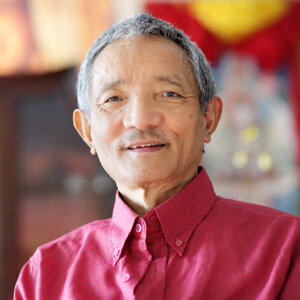
Tulku Thondup: A Guide For Readers
Some Nyingma Lineages: Dudjom Tersar | Longchen Nyingtig | Namcho & Palyul
Other Contemporary Nyingma Figures: Dzigar Kongtrul Rinpoche | Dzongsar Jamyang Khyentse | Thinley Norbu | Phakchok Rinpoche | Khandro Rinpoche
Tulku Thondup Rinpoche was born in Golok, Eastern Tibet, and was recognized as the reincarnation of Khenpo Konchog Dronme, a renowned Nyingma scholar from Dodrupchen Monastery. In 1958 after being forced to flee Tibet, he settled in India where he taught Tibetan and Tibetan literature at Lucknow University and Visva Bharati University. In 1980 he came to the United States and taught at Harvard University as a visiting scholar. Today, he still lives in Cambridge, Massachusetts where he writes, translates, and teaches and dedicates himself to preserving the tradition of Tibetan Buddhism. He is well known for books such as Masters of Meditation and Miracles, The Heart of Unconditional Love, and The Healing Power of Mind, which has now been published in eighteen languages!
In Buddhism, the wisdom taught in the scriptures is mainly aimed at realizing enlightenment. However, spiritual exercises can also help us find happiness and health in our everyday life. There are extensive discourses in Buddhism on improving our ordinary life and having a peaceful, joyous, and beneficial existence in this very world.
-Tulku Thondup, The Healing Power of the Mind
$16.95 - Paperback
All Buddhist traditions teach that the practice of loving-kindness can transform our lives. Here, Tulku Thondup offers a step-by-step guide to a Tibetan Buddhist approach to loving-kindness meditation, which focuses on connecting to Avalokitesvara, the bodhisattva of compassion. Dividing the practice into twelve simple steps, this book provides everything readers need to uncover their innate joy and compassion. The accompanying downloadable audio program guides meditators through the steps of visualizing Avalokitesvara, generating devotion to the ideals he embodies, and radiating loving-kindness to all beings in the universe.
$18.95 - Paperback
The unconditional love that we all long for can be experienced in the practice of loving-kindness. In this popular form of meditation, the love inherent to our own nature is gradually expanded until it embraces infinite beings. Tulku Thondup introduces a new four-stage format for this practice, rooted in the traditional teachings of Tibetan Buddhism: We first meditate on the Buddha of Loving-Kindness as a body of unconditional love and receive his blessings. This spontaneously awakens his unconditional love in our heart. We then find the whole world reflecting back to us as a world of love and peace. Finally, we remain in oneness in the realization of ultimate love.
Loving Kindness is the thought of wishing joy for all beings and the whole universe--without limits and conditions--and putting that wish into practice. The eighteenth-century Dzogchen teacher Jigme Lingpa wrote, "the essence of loving-kindness is wishing happiness for others. Like a loving mother for her [only] child--It is giving up [your care for] your own body, wealth, and [the benefits of] virtuous deeds, and solely serving others and tolerating hardship cause by them." Loving-kindness is love, but it is pure love, love that is totally open, universal, having no limits, unconditional--a love that has no attachment, no ego-centeredness, no self-centeredness.
Meditation on loving-kindness is a training on the thoughts and deeds that benefit others. It is a practice that opens our heart with love to all, causing our life to blossom with feelings of boundless peace and joy.
-Tulku Thondup, The Healing Power of of Loving-Kindness
$34.95 - Paperback
Masters of Meditation and Miracles presents colorful biographies of thirty-five realized teachers whose lives were full of peace, enlightenment, and amazing miracles. They flourished in Tibet, the Roof of the World, in its golden days. These teachers belong to the Longchen Nyingthig lineage of the Nyingma school of Tibetan Buddhism, a cycle of mystical teachings revealed by the great scholar and adept Jigme Lingpa.
$44.95 - Hardcover
In The Practice of Dzogchen, Tulku Thondup translates essential passages from Longchen Rabjam’s voluminous writings to illuminate and clarify this teaching. He also draws on the works of later masters of the tradition, placing Dzogchen in context both in relation to other schools of Buddhism and in relation to the nine-vehicle outline of the Buddhist path described in the Nyingma tradition. This expanded edition includes Counsel for Liberation, Longchenpa’s poetic exhortation to readers to quickly enter the path of liberation, the first step toward the summit of Dzogchen practice.
$18.95 - Paperback
A tulku is a fully enlightened one (buddha) or highly accomplished adept (siddha) who chooses to be reborn again and again for the benefit of all beings. Most tulkus, though, are the rebirths of well-trained masters who are engaged in spiritual training and serving others. Tibetan Buddhists have, for well over a millennium, been meticulously following the tradition of finding, recognizing, enthroning, training, and venerating these revered figures who provide teachings of liberation for both monks and laypeople. This guide to the tulku tradition covers its long history, separating fact from fiction, giving an overview of how the system works, and providing short biographies of some of the great tulkus of the past and present. Included are accounts of the magical occurrences that are associated with these remarkable beings, and advice for how anyone can set out on the tulku path.
Tulku Thondup Offers An Explanation and Guided Meditation on Loving Kindness
In this segment: Tulku Thondup Rinpoche talks about his teacher, Dodrupchen Rinpoche, and his connection with Trungpa Rinpoche.
$21.95 - Paperback
Our minds possess the power to heal pain and stress, and to blossom into peace and joy, by loosening the clinging attitudes that Buddhists call "grasping at self." If we apply the mind's healing power, we can heal not only our mental and emotional afflictions, but physical problems also.
This book is an invitation to awaken the healing power of mind through inspiring images and sounds, mindful movements, positive perceptions, soothing feelings, trusting confidence, and the realization of openness. The healing principle on which these exercises are based is the universal nature and omnipresent power envisioned in Mahayana Buddhism. Yet for healing, we don't have to be believers in any particular faith. We can heal body and mind simply by being what we truly are, and by allowing our own natural healing qualities to manifest: a peaceful and open mind, a loving and positive attitude, and warm, joyful energy in a state of balance and harmony.
Through meditation, we can learn how to encourage our minds to create a feeling of peace in the body. This can be as simple as relaxing and saying to ourselves, "Let my body be calm and peaceful now," and really feeling that this is happening. It is the beginning of meditation--and of wisdom, too.
-Tulku Thondup, Boundless Healing
$26.95 - Paperback
This book offers simple meditation techniques to awaken healing energies in the body and mind. Using Buddhist principles as a basis, Tulku Thondup has created a universal guide that anyone can use. It will benefit those who want to preserve good health as well as those who need comfort and relief from illness or mental distress. Boundless Healing offers:
$29.95 - Paperback
Buddhism teaches that death can be a springboard to enlightenment—yet for all but the most advanced meditators, it will be the gateway to countless future lives of suffering in samsara. Tulku Thondup wrote this guide to help us heal our fear and confusion about death and strengthen our practice in anticipation of this transition, and to help us realize the enlightened goal of ultimate peace and joy—not only for death and rebirth, but for this very lifetime. In simple language, he distills a vast range of sources, including scriptures, classic commentaries, oral teachings, and firsthand accounts. The book includes:
$23.95 - Paperback
This collection of fifteen articles and talks by Tulku Thondup constitutes a manual on how to transmute the situations encountered in daily life, whether external or internal, into spiritual disciplines and experiences. Among the topics covered are:

This reader guide offers a selection of books recommended by Tulku Thondup including cherished classics from the Buddhist tradition.
Check out more reader guides on Tibetan Buddhism!
Learn More about Tulku Thondup and explore his teaching schedule supported by the Buddhayana Foundation
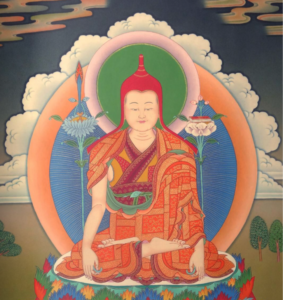
Longchenpa: A Guide for Readers
Longchenpa
A Guide to His Works
Quite possibly the most revered and prolific Nyingma master of all time, Longchenpa was an extraordinary practitioner, scholar, and poet. Known for writing some of the greatest works on Dzogchen, The Great Perfection, today's Nyingma teachers continue to draw from his seemingly infinite well-spring of beautifully composed and profoundly touching works.
Related Topics
Nyingma Lineages: Dudjom Tersar | Longchen Nyingtig | Namcho & Palyul
Nyingma Masters: Rongzompa | Longchenpa | Jigme Lingpa | Patrul Rinpoche | Mipham Rinpoche
Longchen Rabjam was a master known by many names including Drime Ozer, Dorje Ziji, and most notably, Longchenpa, whose name literally means “Great Expanse” as described in H.H. Dilgo Khyentse Rinpoche’s book Primordial Purity. Born in a time of great social, political, and literary change in Tibet, Longchenpa made a significant impact on the development of the Nyingma tradition. Having systematized the tradition in such a way, during a time when the “old school” of the Nyingmas was nearing extinction due to the ever-changing social, political, and religious horizons of 14th century Tibet, the legacy of Longchenpa continues to draw inspiration for today’s Nyingma and Rime teachers alike. Some of his greatest works include his Trilogy of Rest and the many works compiled by Tulku Thondup in the Practice of Dzogchen.
Homeage to Samantabhadra!
—Longchen Rabjam, Prologue from Finding Rest in the Nature of Mind
In Nyingma, Longchenpa is indispensable. His teachings are authoritative works for listening, contemplating, and meditating. Longchenpa had three incarnations as a tertön. The first was as Pema Ledrel Tsal. The second was as the Omniscient Longchen Rabjam. The third was as the tertön king Pema Lingpa. Gyalwa Longchenpa is considered an incredibly learned and accomplished master. If one is sectarian, then there is a tendency to be critical of masters from other lineages, saying, “Well, such-and-such a master is learned, but not accomplished,” or, “That teacher is learned in sutra, but not in tantra.” However, Longchenpa is both accomplished and learned in the sutras and tantras of all the five traditions in Tibet.
Longchenpa’s teachings are so thorough, complete, and logical that there can be no debate about them. So far, no one has really been able to challenge Longchenpa; his position is indestructible. His writings also change the mind of those who read them; they are clearly put forth, in an unerring fashion, and also carry incredible blessings.
—Gangteng Tulku Rinpoche, from the Preface to The Life of Longchenpa: The Omniscient Dharma King of the Vast Expanse
In this sublime revision, Kyabje Thinley Norbu Rinpoche has translated a selection of wisdom teachings into direct and simple English that retains the power of the original writings and their emphasis on practice. The authors are five of the most sublime scholar-saints of the Nyingma lineage of Tibetan Buddhism: Kunkhyen Longchenpa, Kunkhyen Jigme Lingpa, Patrul Rinpoche, Mipham Rinpoche, and Kyabje Dudjom Rinpoche. Their compositions include words of advice, poetic praises, concise daily prayers, and liturgies accompanied by instructions. Written over a span of time from the medieval to the modern era, these precious teachings are intended to be the cornerstones of faith, practice, and enlightenment.
Modern scholar and Nyingma master Khangsar Tenpa’i Wangchuk composed this first and only commentary on the fourteenth-century Buddhist master Longchenpa’s essential text, The Precious Treasury of the Fundamental Nature. The root text establishes the definitive view of the secret class of pith instructions of Dzogchen, the Great Perfection. Tenpa’i Wangchuk’s word-commentary elucidates the nature of phenomena adhering closely to the internal structure of Longchenpa’s verses, clearly presenting the four vajra principles of the nature of phenomena: nonexistence, evenness, spontaneous presence, and single nature.
The Padmakara Translation Group has provided a clear and fluid new translation of Longchenpa’s root text. The commentary by Khangsar Tenpa’i Wangchuk is here translated for the first time, commencing an extended project to render his entire collected works in English. This is an invaluable resource for students of Buddhism who wish to deepen their understanding of the nature of mind and phenomena as presented in the Great Perfection tradition.
Tulku Pema Rigtsal, author of The Great Secret of Mind, gave this talk on Longchenpa and his Seven Treasuries, or Dzik Don. Below you will find both the video and audio.
In Finding Rest in Illusion, Longchenpa does not, like the great madhyamaka authors, lay out his teachings in the form of dry, closely reasoned arguments demanding hard intellectual effort on the part of the reader. In explaining the meaning of the teachings, he aims not to demonstrate but rather to describe. He speaks from the depth of his own realization using examples and imagery, making full use of his superlative poetic gifts.
-Translator’s introduction to Finding Rest in Illusion
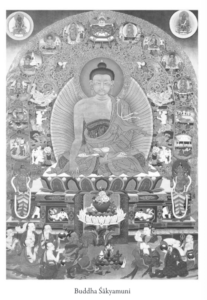
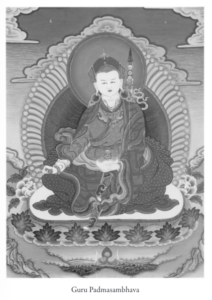
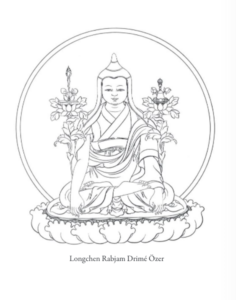
$29.95 - Paperback
Longchenpa’s classic Buddhist manual for attaining liberation teaches us how to familiarize ourselves with our most basic nature—the clear, pristine, and aware mind. Written in the fourteenth century, this text is the first volume of Longchenpa’s Trilogy of Rest, a work of the Tibetan Dzogchen tradition. This profound and comprehensive presentation of the Buddhist view and path combines the scholastic expository method with direct pith instructions designed for yogi practitioners. It sets the foundation for the following two volumes: Finding Rest in Meditation, which focuses on Tibetan Buddhist meditation practice, and Finding Rest in Illusion, which focuses on post-meditation yogic conduct. The Padmakara Translation Group has provided us with a clear and fluid new translation of Finding Rest in the Nature of the Mind along with selections from its autocommentary, The Great Chariot, which will serve as a genuine aid to study and meditation.
$22.95 - Paperback
Longchenpa’s classic exposition of the Buddhist path, the Trilogy of Rest, teaches us how to familiarize ourselves with our most basic nature—the clear and pristine awareness that is the nature of the mind. According to the traditional format of view, meditation, and action, Finding Rest in Meditation is the sequel to Finding Rest in the Nature of the Mind, which establishes the view of the Buddhist path generally, and specifically that of the teachings of the Great Perfection. It precedes the final volume, Finding Rest in Illusion, which focuses on post-meditation yogic conduct. The current volume outlines the main points of meditation, namely, where one should meditate, what qualities a practitioner should possess and develop, and what should be practiced.
$24.95 - Paperback
This third volume of the Trilogy of Rest introduces us to our most basic nature—the clear and pristine awareness that is the nature of the mind. The Padmakara Translation Group has provided us with a clear and fluid new translation of the final volume, Finding Rest in Illusion, along with its autocommentary, The Chariot of Excellence, which describes in detail the conduct of those who have stabilized their recognition of the nature of the mind and how to apply the Buddhist view when relating to ordinary appearances. This is an invaluable manual for any genuine student of Buddhism who wishes to truly find rest through the path of the Great Perfection.
Watch scholar and translator Wulstan Fletcher of Padmakara Translation Group discuss Longchenpa’s Trilogy of Rest and share some of his reflections on Longchenpa.
$24.95 - Paperback
Included in this collection of stories and teachings is Longchenpa’s life story and an introduction to Resting in Illusion, the third text in his Trilogy of Rest.
This volume is a heartfelt, intimate presentation of the entire system of the Nyingma tradition from sutra to tantra to Dzogchen, the Great Perfection, and how through it, modern-day practitioners can succeed in attaining fully realized buddhahood. Inspiring stories of the great masters Longchenpa and Jigme Lingpa kindle the prerequisites of faith and devotion that are the basis for the practices that follow. The Tibetan Buddhist master Nyoshul Khenpo Jamyang Dorje gave these talks during a three-year retreat in France from 1982 to 1985.
“The Practice of Dzogchen enshrines the quintessential teachings of Dzogchen (Dzogpa Chenpo) written by Kunkhyen Longchen Rabjam. He is known as one of the three living Buddhas of Wisdom (Manjushri) of the Tibetan Buddhist world and the supreme authority on Dzogchen. . . .Longchen Rabjam explains that the Dzogchen teachings represent the highest views and hardcore essence of esoteric (tantric) Buddhism. Dzogchen offers meditation methods that awaken the true innate nature of our own mind, buddhahood, swiftly—in this very lifetime or during our bardo journey or, at least, in the next life by our taking rebirth in a pure land.”
-Tulku Thondup, Preface to The Practice of Dzogchen
$44.95 - Hardcover
This classic collection of texts on the meditation practice and theory of Dzogchen presents the Great Perfection through the writings of its supreme authority, the fourteenth-century Tibetan scholar and visionary Longchen Rabjam. The pinnacle of Vajrayana practice in the Nyingma tradition of Tibetan Buddhism, Dzogchen embodies a system of training that awakens the intrinsic nature of the mind to reveal its original essence, utterly perfect and free from all duality—buddha nature, or buddhahood itself.
In The Practice of Dzogchen, Tulku Thondup translates essential passages from Longchen Rabjam’s voluminous writings to illuminate and clarify this teaching. He also draws on the works of later masters of the tradition, placing Dzogchen in context both in relation to other schools of Buddhism and in relation to the nine-vehicle outline of the Buddhist path described in the Nyingma tradition. This expanded edition includes Counsel for Liberation, Longchenpa’s poetic exhortation to readers to quickly enter the path of liberation, the first step toward the summit of Dzogchen practice.
$24.95 - Paperback
Just as the images on television are nothing more than light, so are our experiences merely the dance of awareness. Often we form attachments to or feel enslaved by these experiences. But they are only reflections. As easily as television pictures vanish when the channel is changed, the power of our experiences fades if we penetrate to the heart of reality—the light of the natural mind within everyone.
You Are the Eyes of the World presents a method for discovering awareness everywhere, all the time. This book does not discuss how to turn ordinary life off, and it does not describe how to create beautiful spiritual experiences; it shows how to live within the source of all life, the unified field where experience takes place.
Please note, this is a restricted text. Lean more about how to purchase here
The twenty-two chapters of this tantra elucidate how to correctly view the ground, traverse the path, and ultimately reach the result—fully enlightened buddhahood. The first part of this book includes the Tibetan and English translation for the root tantra itself. The second part is a translation of the extensive commentary on The Guhyagarbha Tantra, called Thorough Dispelling of Darkness throughout the Ten Directions, written by the omniscient Longchenpa, who was an emanation of Samantabhadra. His word-for-word commentary gives uncommon explanations regarding all stages of Vajrayana practice, including comprehensive teachings from the Dzogchen point of view on how to practice and accomplish the path to enlightenment. The author includes complete explanations of the peaceful and wrathful mandalas as well as practical instructions needed to attain the four states of vidyadharahood.
Note that this is a restricted text. See Sangye Khandro's advice on restricted material.
In 1838 Longchen Choying Tobden Dorje, a yogin and scholar of northeastern Tibet and one of the main students of the first Dodrubchen Rinpoche, completed a multivolume masterwork that traces the entire path of the Nyingma tradition of Tibetan Buddhism from beginning to end. Written by a mantra practitioner for the benefit of mantra practitioners living among the lay community, it was intended to be informative, inspirational, and above all, practical. Its twenty-five books, or topical divisions, offer a comprehensive and detailed view of the Buddhist path according to the Nyingma School, spanning the vast range of Buddhist teachings from the initial steps to the highest esoteric teachings of the Great Perfection.
As an heir to Longchenpa, this vast work by Longchen Choying Tobden Dorje is very much based on his teachings. In particular books 15–17 are based on Longchenpa’s explanations of the Guhyagarbha Tantra.
The two volumes in this set are based heavily on
Longchenpa’s commentaries as well as Lochen Dharmasri’s
$59.00 - Hardcover
From Matthieu Ricard’s On the Path to Enlightenment
$22.95 - Paperback
Dilgo Khyentse Rinpoche inspired Matthieu Ricard to create this anthology by telling him that “when we come to appreciate the depth of the view of the eight great traditions [of Tibetan Buddhism] and also see that they all lead to the same goal without contradicting each other, we think, ‘Only ignorance can lead us to adopt a sectarian view.’” Ricard has selected and translated some of the most profound and inspiring teachings from across these traditions.
The selected teachings are taken from the sources of the traditions, including the Buddha himself, Nagarjuna, Guru Rinpoche, Atisha, Shantideva, and Asanga; from great masters of the past, including Thogme Zangpo, the Fifth Dalai Lama, Milarepa, Longchenpa, and Sakya Pandita; and from contemporary masters, including the Fourteenth Dalai Lama and Mingyur Rinpoche. They address such topics as the nature of the mind; the foundations of taking refuge, generating altruistic compassion, acquiring merit, and following a teacher; view, meditation, and action; and how to remove obstacles and make progress on the path.
Included below are works by eminent Nyingma scholars and practitioners who’ve gleaned much of their inspiration from Longchenpa. They include Jigme Lingpa, who according to the tradition, received visions from Longchenpa himself and revealed the Longchen Nyingtik treasure cycle. In addition, masters such as Mipham Rinpoche, Dudjom Rinpoche, Dilgo Khyentse Rinpoche, and many more have drawn from the well-spring of inspiration provided by Longchen Rabjam.
This book is a translation of the first part of Jigme Lingpa’s Treasury of Precious Qualities, which in a slender volume of elegant verses sets out briefly but comprehensively the Buddhist path according to the Nyingma school. The concision of the root text and its use of elaborate poetic language, rich in metaphor, require extensive explanation, amply supplied here by the commentary of Kangyur Rinpoche.
The present volume lays out the teachings of the sutras in gradual stages according to the traditional three levels, or scopes, of spiritual endeavor. It begins with essential teachings on impermanence, karma, and ethics. Then, from the Hinayana standpoint, it describes the essential Buddhist teachings of the four noble truths and the twelve links of dependent arising. Moving on, finally, to the Mahayana perspective, it expounds fully the teachings on bodhichitta and the path of the six paramitas, and gives an unusually detailed exposition of Buddhist vows.
The paperback edition includes Jigme Lingpa’s root text in verse, which was not included in the hardcover edition.
Following the first volume of the Treasury of Precious Qualities, which sets out the teachings of the sutras, the present volume continues Jigme Lingpa’s presentation of the stages of the path and includes a general description of the tantra teachings followed by an exposition of the Great Perfection, regarded in the Nyingma school of Tibetan Buddhism as the summit of all vehicles and the final stage of the path of spiritual training. This concluding volume provides a comprehensive overview of the Nyingma path of Tibetan Buddhism and is presented together with a detailed commentary by Kangyur Rinpoche.
The section on the tantras is a compendious presentation of all-important issues: lineage, empowerment, the generation and perfection stages, and samaya. The section on the Great Perfection is arranged according to the classification of Ground, Path, and Result, and gives an extremely clear introduction to the doctrinal background that underpins the practice of this unique system.
Middle Beyond Extremes contains a translation of the Buddhist masterpiece Distinguishing the Middle from Extremes. This famed text, often referred to by its Sanskrit title, Madhyāntavibhāga, is part of a collection known as the Five Maitreya Teachings. Maitreya is held to have entrusted these profound and vast instructions to the master Asanga in the heavenly realm of Tuṣita.
The Buddhist masterpiece Distinguishing Phenomena from Their Intrinsic Nature, often referred to by its Sanskrit title, Dharmadharmatāvibhaṅga, is part of a collection known as the Five Maitreya Teachings, a set of philosophical works that have become classics of the Indian Buddhist tradition. Maitreya, the Buddha's regent, is held to have entrusted these profound and vast instructions to the master Asanga in the heavenly realm of Tusita. By divesting the mind of confusion, the treatise explains, we see things as they actually are. This insight allows for the natural unfolding of compassion and wisdom. This volume includes commentaries by Khenpo Shenga and Ju Mipham, whose discussions illuminate the subtleties of the root text and provide valuable insight into the nature of reality and the process of awakening.
Three Words That Strike the Vital Point is the famous seminal statement by Garap Dorje that is said to encapsulate all the myriad dzogchen tantras. The key instructions on it by Patrul Rinpoche—the verses known as “The Special Teaching of Khepa Shri Gyalpo”—form the basis for the discourse in Primordial Purity. It explains that in dzogchen, when one has fully recognized that all the confusion of samsara is the expressive power of great emptiness, confusion is spontaneously liberated into the primordial purity of mind’s essential nature.
Counsels from My Heart is one of the few volumes of teachings by Dudjom Rinpoche, a legendary meditation master of the Nyingma lineage of Tibetan Buddhism, to become available in English. It features talks to students presented in Dudjom Rinpoche's characteristically incisive and direct style, bringing the timeless heart-counsels of this great teacher vividly to life.
Introduced and translated by Anne Carolyn Klein
The Longchen Nyingtig Ngondro are the foundational practices found in Jigme Lingpa’s treasure cycle granted to him by Longchenpa. These foundational practices have for over three centuries been one of the most widely practiced and beloved gateways to Dzogchen in Tibet. This compilation of texts includes the story, history, music, and commentaries to help practitioners more fully understand the elements of the practice. With translations of the texts alongside their original Tibetan counterparts, this treasury of materials gives readers the opportunity to explore these beloved teachings in depth.
By Tulku Thondup
Masters of Meditation and Miracles presents colorful biographies of thirty-five realized teachers whose lives were full of peace, enlightenment, and amazing miracles. They flourished in Tibet, the Roof of the World, in its golden days. These teachers belong to the Longchen Nyingthig lineage of the Nyingma school of Tibetan Buddhism, a cycle of mystical teachings revealed by the great scholar and adept Jigme Lingpa.
From the first master, Garap Dorje, to the present, each spiritual personality has his or her own distinctive role to play in this great lineage. In retelling their stories in his own words, the author has sought to bring out their inner feelings as well as their external activities: how they faced and healed physical pain, how they dealt with emotional turmoil, how they overcame spiritual or meditative illusions, and most important, what experiences they had when they awakened their own inner Buddha Mind and Buddha qualities. These biographies not only provide great sources of teachings on meditation, but will also kindle a spiritual flame in the hearts of readers.
Check out more reader guides on Tibetan Buddhism!

And for Tibetan readers, TBRC/BDRC of course provides downloadable pdfs of Longchen Rabjam's works in Tibetan

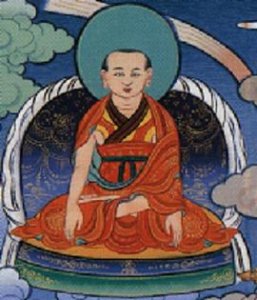
Patrul Rinpoche: A Reader's Guide

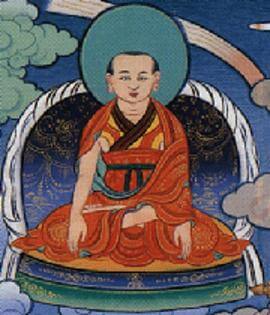
Outwardly, you are the Son of the Victorious Ones, Shantideva.
Inwardly, you are the saint, the conqueror Shavaripa.
Secretly, you are the supreme sublime being Dug-ngal Rangdröl, actual self-liberator of the suffering of beings.
Jigme Chökyi Wangpo, I pray to you.
— by Jamyang Khyentse Wangpo, from Thinley Norbu Rinpoche's Sunlight Speech That Dispels the Darkness of Doubt
Eastern Tibet in the nineteenth century was teeming with some of the most remarkable teachers to have walked on this earth.
Standing vividly out among them was Dza Patrul Orgyen Jigme Chökyi Wangpo, commonly known to us as Patrul Rinpoche. Considered one of the three main incarnations of Jigme Lingpa, the impact that this wandering yogi made on Buddhist practice cannot be overstated.
Biographical sketches of him can be found in Tulku Thondup's Masters of Meditation and Miracles, Khenpo Kunpel's A Vase of Nectar to Inspire the Faithful: A Biography of Patrul Rinpoche, Nyoshul Khen Rinpoche's A Marvelous Garland of Gems, Alak Zenkar Rinpoche's brief biography on Lotsawa House, and as several of the works listed below.
But perhaps the best place to start is in Matthieu Ricard's Enlightened Vagabond: The Life and Teachings of Patrul Rinpoche. Ricard has spent his life with some of the most amazing teachers of the 20th century, many of them heirs to the practice tradition of Patrul Rinpoche and the oral tradition preserving the stories of Patrul Rinpoche, which have been told since his days as a peripatetic wandering in the hills and mountains of eastern Tibet. This book is filled with stories and teachings that will make you laugh and cry and leave you in awe. It is an essential book for those inspired by Patrul Rinpoche's life, works, and wisdom.
What follows is a guide for readers to many of the works available in English by Patrul Rinpoche.
The Words of My Perfect Teacher, or Kunzang Lama'i Shelung, must be one of the most influential works to come out of Tibet. For westerners, the translations, first by Sonam Kazi and then later by the Padmakara Translation Group, have been instrumental in our Buddhist education. In this work Patrul Rinpoche puts to paper a long oral tradition on the preliminary or foundational practices, from the Four Thoughts that turn the mind to Dharma to refuge, bodhicitta, mandala offerings, purification relying on Vajrasattva, and Guru Yoga. It is full of stories that drive the points home in a way that go right to the reader's heart. Lamas have said that this book has a particular quality that rereading it nearly always gives the reader a new discovery. And revisiting it again and again is how it is meant to be used—this is not a work to check the box that you have read it, but for it to become part of the one studying it.
And to go even deeper with it, Kathog Khenpo Ngawang Pelzang, who received it in his youth from Patrul Rinpoche's heart disciple Lungtok Tenpai Nyima, wrote his Zintri, or notes, that form The Guide to the Words of My Perfect Teacher. This work presents the background for the teachings of the main work. For example Patrul Rinpoche's chapter on the Three Jewels corresponds to this work's in-depth exposition on the finer points of the Three Jewels and Patrul Rinpoche's chapter on the mandala offering is complemented by Khenpo's chapter on Buddhist cosmology. Together these two works provide a multi-faceted overview of how to practice.
While Patrul Rinpoche is famed as a Dzogchen yogi, at the core of his practice was the Mahayana ideal of the bodhisattva, a path he truly lived. It is said that Patrul Rinpoche traveled alone, carrying two texts with him. The first was The Way of the Bodhisattva. The second was Nagarjuna's Root Stanzas of the Middle Way.
While Patrul Rinpoche did not compose a work on the Way of the Bodhisattva, he taught it constantly, over one hundred times from beginning to end. It had fallen into disuse outside a few monastic centers, and it is thanks to Patrul Rinpoche this text became integral to all the schools of Tibetan Buddhism. Luckily for us, one of his most dedicated students, Khenpo Kunzang Pelden or Khenpo Kunpel, compiled these teachings he received from Patrul Rinpoche and composed The Nectar of Manjusri's Speech: A Detailed Commentary on Shantideva's Way of the Bodhisattva.
Patrul Rinpoche, also imparted teachings to Mipham Rinpoche, who based his understanding on these when he wrote his commentary on the famous (and famously challenging) ninth chapter of The Way of the Bodhisattva, now translated as The Wisdom Chapter.
On the Abhisamayālaṃkāra, one of the Five Maitreya Texts imparted to Asanga by Maitreya himself, Patrul Rinpoche wrote seven texts, the main two of which are The General Topics on the Abhisamayālaṃkāra and A Word Commentary on the Abhisamayālaṃkāra. What will be surprising for some, the bulk of these two works are, in the honored Tibetan tradition of honoring the words of past masters, is almost entirely excerpts from Tsongkhapa's commentary on the text, The Golden Garland of Explanations.
A distillation (if a 900 page work can be called that) of Patrul Rinpoche's works on this text, are what forms the bulk of Groundless Paths: The Prajñāpāramitā Sūtras, The Ornament of Clear Realization, and Its Commentaries in the Tibetan Nyingma Tradition
Watch scholar and translator Karl Brunnholzl discuss the trilogy of commentaries on Prajaparamita, of which Groundless Paths, heavily focused on Patrul Rinpoche, is the third volume.
The Speech Virtuous in the Beginning, Middle, and End, one of the most influential works of Patrul Rinpoche, is included is included in whole or in part in several books. Patrul Rinpoche wrote this while staying in a remote cave not far from the Tibetan-Chinese border. In this work, be pulls the rug from under our normal way of being, so full of deceit and hypocrisy. He concludes that only by turning away from an ordinary life and pursuing the path of Buddhism. He then outlines the preliminary practices, the development and completion stages of tantric practice, and finally the practices of Mahamudra and Dzogchen. This text is full of the wisdom, humor, and directness that characterize all of Patrul Rinpoche's works, but it is unique in that it is meant to be memorized, making its message easy to bring right into our hearts.
In the accompanying commentary to Patrul Rinpoche's root text, Dilgo Khyentse Rinpoche (1910–1991)—lineage holder of the Nyingma school and one of the great expounders of the Dharma in Europe and North America—expands upon the text with his characteristic compassion and uncompromising thoroughness. Patrul Rinpoche's fresh and piercing verses combined with Khyentse Rinpoche's down-to-earth comments offer a concise yet complete examination of the Buddhist path.
Another superb translation of the root text of Patrul Rinpoche's The Practice of the View, Meditation, and Action, Called “The Sublime Heart Jewel”, The Speech Virtuous in the Beginning, Middle, and End is included in Thinley Norbu Rinpoche's collection of translations entitled Sunlight Speech That Dispels the Darkness of Doubt. This text presents advice to practitioners on the path to enlightenment, which is all contained in the three aspects of the correct view, meditation, and action, synthesized in the practice of the Six-Syllable Mantra of Avalokiteshvara.
Two poems of Patrul Rinpoche are included in what in the mind of your author here is one of the most extraordinary anthologies of Tibetan Buddhism: Straight from the Heart: Buddhist Pith Instructions.
The first poem is an excerpt from Speech That Is Virtuous (see the entry from Sunlight Speech in this article) and the translator has titled it Afflictions Are Wisdom, the Skandhas Are Avalokitesvara. The second is The Crucial Point of Practice.
Thinley Norbu Rinpoche also quotes this at length in Sole Panacea: A Brief Commentary on the Seven-Line Prayer to Guru Rinpoche That Cures the Suffering of the Sickness of Karma and Defilement.
Patrul Rinpoche wrote multiple works on tantric practice, several of which have been translated into English.
Patrul Rinpoche wrote two extremely helpful texts on generation stage practice which are included in Deity, Mantra, and Wisdom.
The first is Clarifying the Difficult Points in the Development Stage and Deity Yoga and is meant to be a companion piece to Jigme Lingpa's Ladder to Akanishta which accompanies it in this volume. As the translators explain, "Expanding on the presentation given in Ladder to Akaniṣṭha, he highlights some of the more obscure issues addressed by Jigme Lingpa and clarifies the latter’s presentation. In addition to his clarification of difficult issues, Patrul also stresses the importance of compassion and the view of emptiness in the context of tantric practice."
The second text by Patrul Rinpoche in this volume is The Melody of Brahma Reveling in the Three Realms: Key Points for Meditating on The Four Stakes That Bind the Life-Force. These Four Stakes are absorption, essence mantra, unchanging realization, and projection and absorption. Patrul Rinpoche lists they key points associated with each of the four. Together, they form an essential framework in development stage practice according to the Nyingma tradition.
Hear Dharmachakra Translation Committee member Andreas Doctor discuss this book, its background and their teacher Chokyi Nyima Rinpoche's encouragement to bring this important work to a western readership.
These Four Stakes discussed above, central as they are to the Nyingma tradition, are unsurprisingly essential in the Lonchen Nyingtik lineage. The the main lama practice is the Rigdzin Düpa, or Gathering of the Vidydharas, a practice centered on Guru Rinpoche Padmasmbhava and other awareness holders. One of the translations of this volume is by Khangsar Tenpe Wangchuk which is a commentary on Patrul Rinpoche's Melody of Brhama discussed above, and Padmasambhava'a Garland of Views.
The following text in the volume is a short one authored by Patrul Rinpoche himself, and is titled A Clearly Reflecting Mirror: Chöpön Activities for the Rigdzin Düpa, the Inner Sadhana of the Longchen Nyingtik Cycle. This is a ritual manual for a multi-day drupchö intensive practice. It covers arranging the mandala, the Rigdzin Düpa torma, Fulfillment-and-Confession torma, the Dharmapala tormas, additional offerings, various offering activities for the attendants, tsok, remainders, Dharmapala practice, the horse dance, offerings, and prayers for auspiciousness.
Hear Matthieu Ricard discuss Patrul Rinpoche's advice on meditative progress and experiences
All of Patrul Rinpoche's works regardless of the subject are imbued with the view of Dzogchen. However, he authored many works explicitly on this system of practice.
One of Patrul Rinpoche's most famous Dzogchen texts is The Three Words That Strike the Vital Point, itself based on a short work by the early Dzogchen master Garab Dorje which he had imparted to Manjusrimitra. This text, along with a commentary by Dilgo Khyentse Rinpoche is included in Primordial Purity. This work is an overview of the view, meditation, and action of Dzogchen. As Khyentse Rinpoche explains, these are not ordinary teaching:
"If you practice accordingly, you cannot help but be liberated. It will not be enough, however, just to practice for one or two days. In such a short time, we cannot break through our confusion. Even though you cannot spend your whole life continuously practicing in solitary retreat, please do as much practice as you can every day. As it is said, 'A collection of drops can become an ocean.' Since the teaching becomes more and more profound through continuous practice, confusion will naturally be purified, and all good qualities will spontaneously unfold. Those are the key instructions of the gurus of the three lineages."
The Nature of Mind: The Dzogchen Instructions of Aro Yeshe Jungne is a commentary on a fascinating text by Patrul Rinpoche by the Khenpo brothers Palden Sherab and Tsewang Dongyal. It is centered around a translation of Patrul Rinpoche's Clear Elucidation of True Nature: An Esoteric Instruction on the Sublime Approach of Ati. This text Patrul put together to encapsulate all the teachings from the Aro tradition in a single short text. It is a pithy guide to discovering the nature of your own mind and gives explicit instructions on how to do so for those of us of superior, middling, and lesser capabilities. It is superb.
Beyond the Ordinary Mind, an extraordinary collection of profound advice on Dzogchen from many great masters, compiled and translated Adam Pearcey, the force behind Lotsawa House. The piece by Patrul Rinpoche is called Uniting Outer and Inner Solitude: Advice for Alak Dongak Gyatso. Alak Dongak Gyatso was a student of Patrul Rinpoche and Pearcey tells a few stories about this somewhat elusive figure who was on the losing end of the stick in a debate with Mipham Rinpoche and writes that this work,
"is more than just a poem of advice on the importance of remaining in solitude. It offers Patrul Rinpoche’s views on a subject close to his own heart: he spent most of his life in retreat and even wrote this text while residing in 'the mountain solitude of Dhichung.' But it is also one of the few surviving textual clues to the mysterious life of Alak Dongak. And if we read it as a moving attempt to console a dear but despondent disciple, then it has a further dimension, as an encouragement to respond to an ordinary human situation by transcending ordinary human limitations."
The Golden Letters: The Tibetan Teachings of Garab Dorje, First Dzogchen Master includes a work by Patrul Rinpoche entitled The Special Teaching of the Wise and Glorious King, a four page poem followed by a more extensive auto-commentary.
His Holiness teaches on Patrul Rinpoche's commentary to Garab Dorje's famous Three Words That Strike the Vital Point, also using other texts such as Longchenpa's Cho Ying Dzod, or Treasury of Dharmadhatu. His Holiness says,
Fundamentally, no matter who we are, whether we meditate or not, the self-arising wisdom of rigpa is already primordially present, and we have never strayed from it. Then there is rigpa as it is directly introduced to us by a master, on the basis of our personal practice. The nature of rigpa in both cases is identical—it is uncontrived rigpa—but in the one case it is simply so, without having been directly introduced, while in the other case we are recognizing our true nature for what it is. So one can talk about rigpa in two ways. But actually, there are not two things, one reuniting and another being reunited. The direct introduction to what is naturally present as the ground of being is metaphorically called “reuniting mother and child.
The first section of this book is a translation of a four page poem by Patrul Rinpoche addresses to the adept Abushri. It is a beautiful piece of advice that cannot fail to move the reader.
Patrul Rinpoche wrote a short work called Chase Them Away! which was translated by Herbert Guenther. This is included in the anthology The Buddha and His Teachings. It appears this work was written when he was an old man as it is a reflection of his life, looking back and telling us "like it is". It reflects the wisdom from a life dedicated to practice and benefiting others. Here is one of the verses:
When first I saw wealth,
I had the feeling of momentary joy
Like a child gathering flowers:
That's what is meant by not hoarding riches and wealth.
When later I saw wealth,
I had the feeling of there never being enough
Like water being poured into a pot with a broken bottom:
That's what is meant by making small efforts to gain something.
When now I see wealth,
I have the feeling of its being a heavy burden
Like an old beggar with too many children:
That's what is meant by rejoicing in having nothing.
There are three excellent sources for more on Patrul Rinpoche.

![]() The Treasury of Lives also has a biography of Patrul Rinpoche among its collection of Tibetan figures.
The Treasury of Lives also has a biography of Patrul Rinpoche among its collection of Tibetan figures.
And for Tibetan readers, TBRC/BDRC of course provides downloadable pdfs of Patrul Rinpoche's works in Tibetan.
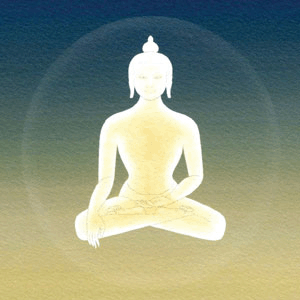
| The following article is from the Summer, 2002 issue of the Snow Lion Newsletter and is for historical reference only. You can see this in context of the original newsletter here. |
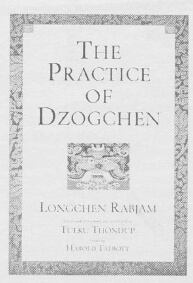
"This is one of the most significant works on Tibetan Buddhism to be published in recent years, treating with grace, beauty and depth a most important subject. This is undoubtedly one of the most comprehensive works on the Nyingma to appear in English."—Glenn H. Mullin, Tibetan Review
"An invaluable guide for those who seriously wish to experience of the true nature of the mind."—Parabola Magazine
"Authoritative, comprehensive and clear. This book fills a major gap."—Matthew Kapstein, University of Chicago
Longchen Rabjam (1308-1363) is the most celebrated writer and adept of the Nyingma School of Tibetan Buddhism. His excellent writings on the view, meditation and the result in Dzogchen, and in the sutras and tantras make up the core of this book.
In his masterful introduction to the body of this work, Tulku Thondup covers the three outer and inner tantras, the three division of Atiyoga, Dzogchen and the other yanas and traditions, and last but not least—excerpts from the exemplar lives of teachers (including Longchen Rabjam) to illustrate the ways of training in Dzogchen.
Tulku Thondup Rinpoche is the author of The Healing Power of Mind (with Daniel Goleman) and Boundless Healing, and lives in Cambridge, MA.
The following is a section entitled "Twenty-seven Courses of Training in Dzogpa Chenpo" from The Practice of Dzogchen.

In The Meaning Instructions on Three Virtues of Relaxation in the Natural State of The Mind, Longchen Rabjam presents a hundred and forty-one courses of training divided into three chapters. The first chapter is on outer common teachings of Sutra, the second is on inner esoteric teachings of Tantra, and the third chapter is on the innermost resultant teachings of the Great Perfection (rDzogs Pa Chen Po). The following is an abridged translation of the third chapter, which has twenty-seven courses of training.
IDENTIFICATION (OF THE BASIS) THROUGH (UNDERSTANDING THE) VIEW
The External Apprehended Objects Are Non-Existent Emptiness
(i) The appearances are unreal reflections like the eight examples of illusion. Every aspect of the five objects, such as form, included in the phenomena of the world and beings, are mere appearances with no true existence. All the appearances which have appeared to both the pure perceptions of the Buddhas and the impure perceptions of deluded beings are the percepts of wisdom and the mind. While the appearances are appearing to both perceptions, they are appearing with no inherent existence (Rang-bZhin), like a reflection in a mirror and rainbow rays in the sky. To the pure perception of wisdom the (appearances) transcend the extremes of existing and non-existing as there are no stains of apprehender and apprehended. As there is no creating, ceasing, and changing, all are free from the characteristics of compounded phenomena, the appearances of uncompounded emptiness-form, and are totally free from conceptualizations. To the perception of the deluded mind, (the appearances) merely appear as the object of apprehension of self (bDag-'Dzin), which have fallen into the extreme (concepts) of existing or non-existing, are detached from the characteristics of uncompounded (nature), and have strengthened the habituations of adventitious and circumstantial self-perceptions. So, here, one will understand that the objects, the delusory appearances of the mind, are unreal. Various external appearances, such as white and red, are merely the percepts of rigid habits, like a dream created by the drunkenness of ignorant sleep. There is not the slightest existence (in them) as the object in the (true) meaning. Also, those appearances are not mind from the very point of their arising, because their substantial characteristics, such as color, size, and distinctions, negate the character of the mind. At the same time, they are not other than the mind, because, in addition to their being merely the delusory perceptions (of the mind), no other object has ever been established as such. The appearances to the mind are just types of experience of rigid habits continuing from beginningless time. It is like dreaming last night about a magic show one has seen yesterday. Therefore, one should think that whatever appears are appearances of non existence, and are without foundation, abiding place, natural existence, and recognizable (entity). They are merely a clear appearance of the empty nature like a dream, magical display, mirage, echo, shadowy view (Mig-Yor), water-moon (reflection), miracle, and the city of smell-eaters (a spirit world). Whatever appears, self or others, enemies or friends, countries or towns, places or houses, food or drink or wealth, and whatever one does, eating or sleeping, walking or sitting, one should train in seeing them as unreal. One should devote oneself to this training in all its aspects: the preliminary, actual, and concluding practices.
(ii) The objects, if analyzed, are emptiness. If the appearances are examined from gross to subtle down to atoms, they are partless and non-existent. So form is emptiness. (Likewise,) by examining color and recognition of sound, it (will be found to be) emptiness. By examining the form and essence of smell, it (will be found to be) emptiness. By examining the aspects of taste, they (will be found to be) emptiness. Especially, by examining the sources (sense-objects), the emptiness of touch will be reached. Although they are different in appearance, they are the same in their nature in being emptiness, so the emptiness of various objects are not separate categories. Their nature, like pure space, transcends being either separate or the same. So the nature of objective appearances is emptiness in its essence.
The Apprehender Has No Foundation and No Root
(i) The consciousnesses are self-clarity without foundation.
(There are eight consciousnesses.) The five sense-consciousnesses; arise as the five objects such as form, the mind-consciousness cognizes the general impression (of the appearing objects) and designates them as the objects, the defiled mind-consciousness is the sense of negating, accepting, hating and disliking (etc.), the mind-consciousness arises after the six consciousnesses (five senses and universal ground consciousness), ...and the consciousness of universal ground is self-clarity (Rang-gSal) and no thought and is unrelated to the objects: these are the eight or six consciousnesses. At the (very) time of (functioning of any of) those consciousnesses themselves, whatever consciousness it is, it is clear, vivid, and self-clarity with no foundations. Although they appear clear, there is no substantial entity. They are appearing without existence, like clear space and a breeze with no dust. Their clarity is present naturally like the sky without clouds. Their movements are like wind, not in distinguishable substances. From the (very) time of appearing, (the consciousnesses) as the apprehenders are self-clarity and unrecognizable. Watch them when they are arising and when they are abiding. Relax naturally and watch the manner of appearing of the apprehender. Thereby one will realize the apprehenders as having the nature of merely an appearance of clarity with no existence, emptiness with no bias, and self-clarity with no foundation.
(ii) (The subject), if analyzed, is emptiness without root.
By analyzing (whether) the self-clear, baseless mind (exists) in the external appearances, inner physical body, or intermediate movements, or if the entity of the self-dwelling mind itself (can be) recognized in (its) design, color, birth, cessation, and abiding, one will realize that its nature is non-existence, baseless and free from the extremes of either existence or non-existence. In this training the devotion to the Lama is the only important thing.
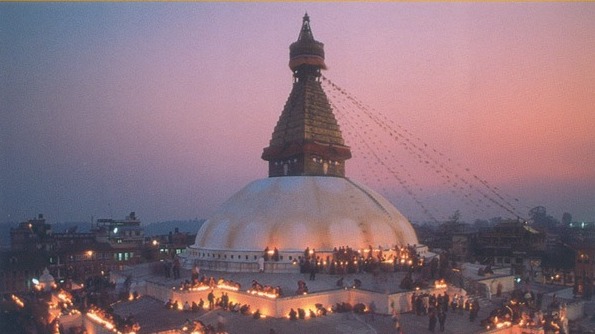
The following is an excerpt from
By Longchenpa
Introduction by Chogyal Namkhai Norbu
Translated by Kennard Lipman & Merrill Peterson
$24.95 - Paperback
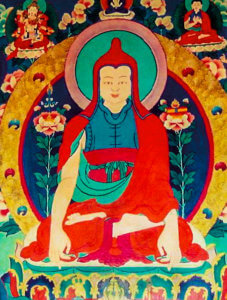
| The following article is from the Spring, 1950 issue of the Snow Lion Newsletter and is for historical reference only. You can see this in context of the original newsletter here. |
You Are the Eyes of the World presents a method for discovering awareness everywhere, all the time. This book does not discuss how to turn ordinary life off, it does not describe how to create beautiful spiritual experiences; it shows how to live within the source of all life, the unified field where experience takes place.
The real subject matter, the way the teaching is set forth, has four parts: (1) becoming certain through the perspective of the teaching; (2) transcending limitations through accustoming yourself to this perspective; (3) overcoming obstacles through the way you conduct your life; (4) abandoning hope and fearthe result.
Becoming certain has two parts: (1) certainty that what appears is the play of experience itself, (2) determining that experience itself is open.
The Play of Experience
All experiences and life-forms cannot be proven to exist independently of their being a presence before your mind, just like a lucid dream.
All that is has universal creativity, pure and total presence as its root.
How things appear is my being.
How things arise is my manifestation.
Sounds and words heard are my messages expressed in sounds and words.
All the capacities, forms, and pristine awarenesses of the buddhas;
The bodies of sentient beings, their habituations, and so forth,
All environments and their inhabitants, life forms, and experiences;
Are the primordial state of pure and total presence.
Not realizing that everything is nothing other than the manifestation of one's mind is called samsara.
Without understanding me, the creativity of the universe,
But investigating the phenomena that I manifest,
You perceive everything dualistically due to your attachment and longing.
Impermanent, apparitional tilings will fade away.
They are aimless, like a blind man.
Accustom yourself to this nondual reality where the duality of mind and that which appears before mind are like a dream.
All that is experienced and
Your own mind are the unique primary reality.
They cannot be conceptualized according to the cause and effect systems of thought.
Investigate your mind's real nature
So that your pure and total presence will actually shine forth.
The concrete states of matter-solids, liquids, and so forth-should be examined in this way. Remaining for ten days where no otherness can be found, you will realize that not even an atom's worth of anything exists that is separate from pure and total presence. Realizing that, you will certainly be free from all fabricated obsession with the otherness of objects. Moreover, the very being of what is experienced externally, in being an essenceless, open dimension, is shown to be the state of pure and total presence. In being the variety of unceasing experience, it is shown to be the play of pure and total presence. This is not the same as claiming that whatever you experience is mental because what you experience is not a mental event but arises as the play of the state of pure and total presence. That claim does not distinguish between mind and the state of pure and total presence. The state of pure and total presence is the clear light, the pure fact of awareness, non-conceptual ever-fresh awareness-, whereas mind is the motivating factor of samsara pervasive conceptualization. As The Two Truths says:
Mind and mental events are concepts, mere postulations within the three realms of samsara.
Whenever the state of pure and total presence is recognized, mind and mental events cease. Mind is objectification; pure and total presence does not objectify. Therefore, even the subject which is held to be mental is also seen to be the originally pure state of being.
Experience is Open-Dimensional
Because we are unagitated within, there is no object to seek within.
Since there is no attachment to an object, there is no object to seek as a support.
With the compassion which does not arise, does not cease, and is selfless,
Being-for-others is always available. It does not need to be brought about.
Therefore, examine this present mindful awareness internally, externally, and in between. First, where does it come from? Where does it rest now? Finally, where does it go? Can you determine its color or shape? Wherever this awareness is present, is it an object which appears externally? Is it one of the psychological constituents of a person? Does it exist somewhere in between? Since you have not found this awareness by examining and analyzing what appears externally or internally, you ought to conclude that even the ten essential aspects of tantra are also not found upon inquiry. When you investigate whether perspective, meditation, commitment, charismatic activity, mandala, empowerment, stages of cultivation, paths to traverse, obstacles to purify, pristine awarenesses, or buddha activity exist in their own right or are founded on something else and do not find any of these to exist in reality, this is known as The great transcendent nonmeditation, the real significance of the ten primordially pure aspects of tantra.
[Because my creativity is beyond all affirmation and negation,]
I determine all events and meanings.
Because no objects exist which are not me,
You are beyond perspective or meditation.
Because there does not exist any protection other than me,
You are beyond charismatic activity to be sought.
Because there is no state other than me,
You are beyond stages to cultivate.
Because in me there are, from the beginning, no obstacles,
You are beyond all obstacles; self-arising pristine awareness just is.
Because I am unborn reality itself,
You are beyond concepts of reality; subtle reality just is.
Because there is nowhere to go apart from me,
One is beyond paths to traverse.
[Because all buddhas, sentient beings, appearances,
Existences, environments, and inhabitants]
Arise from the quintessential state of pure and total presence,
One is beyond duality.
Because self-arising pristine awareness is already established,
One is beyond justifying it; the transmission of this great teaching provides a direct entry into understanding.
Because all phenomena do not exist apart from me,
One is beyond duality. I fashion everything.
According to the capacities of the individual, this will be recognized in three, five, or eleven days.
Accustoming Yourself to the Perspective
After having become certain by means of this perspective, which is based on the absence of any partiality in the pure fact of awareness, begin by relaxing your body and mind in a solitary place. Abandon fear and haste. Seated in the seven-point meditation posture of Vairocana, having been instructed by the master, relax in the ongoing state of complete self-settledness without hope, fear, contrivance, or addition. This is majestic utter sameness that pure fact of being where mind and what appears are primordially pure. This itself is the deep experience of the inconceivable, fundamental dimension of reality.
Listen, great being, understand in this way:
The way things appear are one in their pure fact of being.
Do not make any corrections here.
This king, uncontrived sameness,
Is the conceptless deep experience of the fundamental dimension of reality.
Simply stay with that.
Thus you should let the mind, which is present right now, be in this total sameness of primordial purity that is like the sky and is free of any effort of body, speech, or mind. Relax the mind-in-that-naked state of presence which exists when you are not caught up in whatever objects may appear. Then there arises, without any intellectual elaboration, an ongoing lucidity which is not caught up in any appearances or concepts. This is the deep experience of creativity, the primordial freedom of mind itself.
Listen, vajra being, now practice correctly.
When meditating on pure, unborn reality
What appears is neither concretized nor latched onto.
Because what appears never becomes what it seems to be and is intrinsically free,
By realizing how things are you are freed without having to meditate on emptiness.
This is the deep experience of self-originating clear light.
In this bliss which, in its very being, is free from concepts
There is nothing to objectify, seek, or contrive with body, speech, or mind.
There is nothing to focus on or characterize.
just relax in the reality of this blissful self-generating pristine awareness.
This is the deep experience of self-originating clear light.
This is the activity, in its deepest sense, of the majestic creativity which fashions everything.
Settle into this uncontrived, stainless intrinsic clarity for as long as possible. Whatever thought arises in this dimension should be looked at nakedly. Rest there. By being right there, that thought, without having to be eliminated, is released. Remaining with that state of contemplation, the thoughts release themselves right away like a drawing on water.
In the uncontrived state of the victorious ones,
Whatever mental states and thought processes arise never become what they seem to be.
If you know that this is the situation
You are free from all notions about striving.
And,
All the movements of mental activity whatsoever
Do not distract you from the unborn dimension.
Know that whatever thoughts arise are meditation,
Even when not meditating, you will not be distracted.
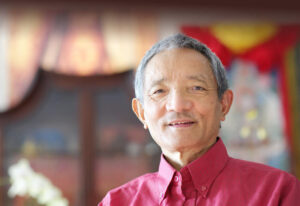
| The following article is from the Winter, 1996 issue of the Snow Lion Newsletter and is for historical reference only. You can see this in context of the original newsletter here. |
by Longchen Rapjampa Introduced, trans, and annotated by Tulku Thondup Rinpoche Ed. by Harold Talbott
482 pp. ISBN 1-55939-054-9 $22.95
The following is excerpted from the translator's preface to The Practice of Dzogchen.
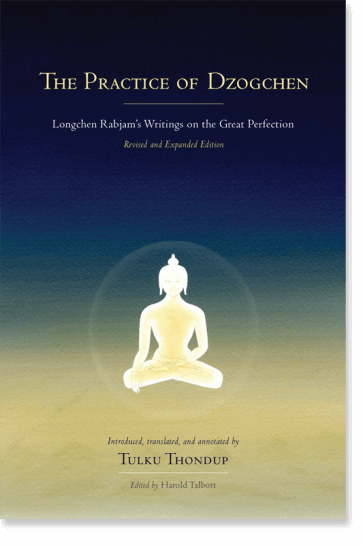
Dzogpa Chenpo meditation is the method of training of utmost simplicity in order to reach the most simple state free from conceptual elaborations. But for ordinary people like us, to attain the state of utmost simplicity and ease is the hardest goal to accomplish. Thus, to prepare for the Dzogpa Chenpo training, one has to do various preliminary studies and train ing in order to learn the path and purify the stains of negative emotions with their traces; to generate positive energy through the force of virtues; and to realize, refine and perfect the ordinary meditative attainments taught in the common Buddhist paths. When one is ready, in accordance with the strength of one's spiritual experiences, one should be instructed in the Dzogpa Chenpo meditation by a qualified master.
For the happiness and enlightenment of beings, Buddhism works with the root, the root of gaining joy and dispelling misery, which lies in individuals; for society is a collection of individuals. For an individual, the mind is the main factor and the forerunner of all activities. So the improvement and perfection of the mental state is the primary emphasis of Buddhist training. If one has improved and perfected one's mind, all one's physical activities will be naturally perfect and one's presence and activities will become a source of true happiness and enlightenment for others. From the moment of becoming a Mahayana Buddhist, one is expected to exert oneself in the service of others. The whole aspiration in spiritual training is for the sake of others. But at the beginning, the emphasis will be on the spiritual progress of oneself, deriving from one's own mind. Without spiritual strength within oneself, trying to serve others will be as a Tibetan proverb says: A falling person cannot give his shoulder to another falling person to rely on.

Without spiritual strength within oneself, trying to serve others will be as a Tibetan proverb says: A falling person cannot give his shoulder to another falling person to rely on.
The meditations of tantra and of Dzogpa Chenpo taught and transmitted by Guru Padmasambhava are a training on the balanced path of the view of primordial wisdom and the activities of meritorious applications. They are neither a contemplation on mere view, although some interpret them thus, nor training on just meritorious activities. Guru Padmasambhava said to King Thrisong Deutsen (790-858):
Please do not lose the view in favor of activities. If you do, being tied to existential characteristics, you will not attain liberation. Please do not lose activities in favor of the view. If you do, there arises (a situation of) absence of both virtues and vices (and one falls into the extreme of) nihilism, and (one's spiritual life) becomes irreparable. 0 great king, as my tantras possess extensive (teach ings on) view, in the future many people who know the words [textual expression] of the view but lack the confidence of the view in their mental continuum could stray into inferior realms
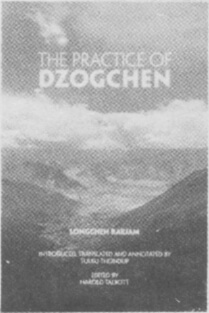
The cover of an earlier edition and what is in the newsletter
In Dzogpa Chenpo meditation itself there are numerous stages of training which must be taught and practiced step by step. Each step is taken only when the trainee is ready for it. In Dzogpa Chenpo, a subtle and esoteric meditation which transcends intellectual and mental fabrications, one doesn't study or read the teachings on a particular aspect until one is ready for that particular step of experience and for training on it. And one is definitely excluded from instructions on experiential meditation (Nyams-Khrid or dMar-Khrid). If, without being ready for the particular meditative experiences, one reads about or studies them, one could just build up fabricated images of intellectual understanding about a particular meditative experience. Thereby, before having any true experience or pure realization, one could fall into the pit of mental creations. Then the trainee will find it hard even to distinguish whether it is a true experience of realization or a mentally created image. This way of introduction applies not only to Dzogpa Chenpo, but also to general tantric training. In sutric teaching, first you study and then enter into the training. But in the tantras, when you have matured through the common preparatory virtues and are ready for the esoteric training, you will receive the transmission of the realization through an Empowerment (dBang, S.abhisekha) ceremony. Only then will you be introduced to the course of study and training in the tantra by using the Primordial Wisdom, the meaning of the empowerment (dBang-Don Gyi Ye-Shes), which is realized during the transmission of empowerment, as the means and the basis of meditation. Some people do not need to undergo any common training but are ready for higher training such as Dzogpa Chenpo. But such people are a bare possibility in this world of ours.
Therefore, in this book I have tried to avoid including any instructions on the stages of experiential meditation, since one should get them individually from a true master in person, stage by stage, according to one's own experiential abilities. I have tried to present here only, or at least mainly, the teachings on view, the outline of the meditation, and the result of Dzogpa Chenpo.
Nowadays, as the cultural context of the traditional teachings is changing, the tantric teachings and even the Dzogpa Chenpo teachings are being given in public to many people who may have little belief, who have done no preliminary train ing or have received no introductory empowerments. The main focus of attraction and the goal of many so-called masters and disciples unfortunately have become worldly or sensual attributes. On the other hand, there are many serious Dharma people who wish to study Dzogpa Chenpo teachings out of pure Dharma interest, and who are prepared for such teachings through preliminary study and training. But the lack of instruction and reading material in Western languages is preventing them from making much progress on this path. In this situation, it is a serious decision whether or not to write and translate such teachings and make them public. Realistically, in this modern age, there is no way that these teachings could be preserved and practiced traditionally only by those who are ready for them. So the alternative is to consider what will be the best possible way to present the teachings to the public so that they will be of most benefit to the people whom they will reach.
After all these considerations, I reached the conclusion that I would attempt to translate and present these original scriptures, the very words which came from the wisdom of the Enlightened Ones, unstained by the contemporary intellectual thought of this modernistic world or ours. ä_æ
